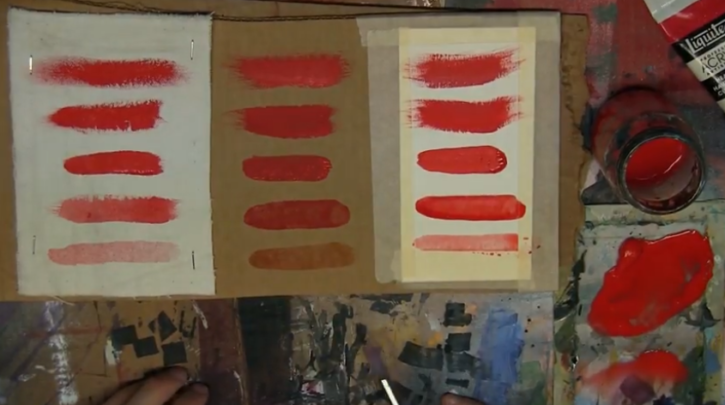In this acrylic painting tutorial, we will look into a question a lot of beginners ask us: How to thin your acrylic paint. This concept is important and will help you to detail your paintings. Thanks a lot to Cinder Block Studios for this tutorial! Make sure you support their Patreon for all the great advice they provide us.
Let’s start!

Thinning your acrylic paint with water, a bad idea?
If you’ve been watching acrylic artists on YouTube or read the paint manufacturers advice, I am sure you heard that you shouldn’t use more than 20% water to 80% paint or 25% to 75%. A lot of people say that if you go above this ratio and you add too much water it destroys your acrylic paint which isn’t true!
Try to clean your brushes only using water and you will see if it “destroys” the paint.
Then why do paint manufacturers and other artists say that water is such a big problem?
The short and simple answer is, it’s to sell more products. Paint manufacturers want you to try their mediums and their gels in addition to the paint you buy.
I actually painted for almost 12 years before I even knew acrylic mediums’ existence. The only thing I had was water and in all that time I never noticed a problem by mixing acrylic with water.
Whether you are painting thin or thick, the thing that determines whether or not your paint sticks to the surface is how absorbent the surface.
If you’re painting on canvas, a smooth paper or even a smooth piece of wood, thinning with water will work well.
The only surface that could be problematic is a non-porous surface, like glass for example. In this case using a medium or a gel will help to adhere it.
Meanwhile canvas is a cloth, it is absorbent and it doesn’t matter how wet you paint is, it is going to adhere and bond to that underlying surface.
Also if you’re using a cheap low end paint that has a reduced quality binder or too much water in its formula, mixing more water in it could get bad results. But that’s only really a factor in the manufacturing of the paint and not so much in doing the painting.
Experiment: Thinning acrylic paint with water on 3 classic surfaces.
To prove my point, I will show you by using some cadmium red paint with different water dilution ratio on three surfaces: paper, cardboard and canvas.

I start by using a dry brush with no water and apply it on the surfaces.

Then I dunk my brush a little bit in the water and then in the paint. The paint is still thick, probably 2 to 5% dilution.

Now, let’s get that ratio to the 30% mark we talked about in introduction. This is about what manufacturers would say is all the further you should take your paint.

Now, let’s get extreme and add a lot of water and make the paint really transparent.

To push it even further, this time I take as much water as I can with my brush and put it on my palette. Then I add a little bit of paint. It is actually a good technique to get a washy watercolor effect with acrylic.

I now wait for it to dry completely.
Once dry, I use a knife to scratch the different surfaces. Surprisingly, as can be seen below, the thinner my paint is the more it adheres to the surface.

Learning How to Thin Acrylic Paint is Easy!
I hope this experiment convinced you that thinning down your acrylics with too much water is just false. Whether you’re using thick out of the tube paint or a medium or soft buddy it doesn’t matter how much water you add.
Mediums and gels allow the paint to dry to a harder surface and to stick to things like glass or other smooth surfaces.
If you have questions about this technique, feel free to reach us by using the comments below. We’d be happy to answer your painting concerns!
Happy Painting 🙂


